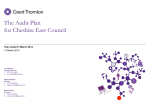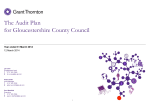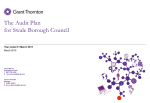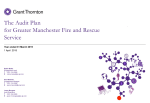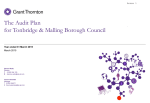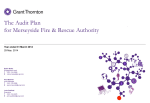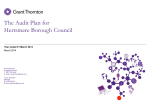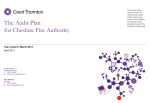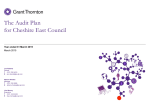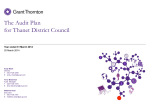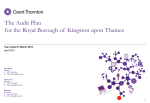Download The Audit Plan – template user guide
Transcript
APPENDIX B The Audit Plan for Lancashire County Pension Fund Year ended 31 March 2013 11 March 2013 Karen Murray Director-Public Sector Assurance T 0161 234 6364 E [email protected] Fiona Blatcher Associate Director – Public Sector Assurance T 0161 234 6393 E [email protected] Ian Pinches Executive T 0161 234 6359 E [email protected] © 2013 Grant Thornton UK LLP | The contents of this report relate only to the matters which have come to our attention, which we believe need to be reported to you as part of our audit process. It is not a comprehensive record of all the relevant matters, which may be subject to change, and in particular we cannot be held responsible to you for reporting all of the risks which may affect the Council or any weaknesses in your internal controls. This report has been prepared solely for your benefit and should not be quoted in whole or in part without our prior written consent. We do not accept any responsibility for any loss occasioned to any third party acting, or refraining from acting on the basis of the content of this report, as this report was not prepared for, nor intended for, any other purpose. Contents Section 1. Understanding the business of your pension fund 2. Developments relevant to your pension fund and the audit 3. Our audit approach 4. An audit focused on risks 5. Significant risks identified 6. Other risks 7. Results of interim work 8. Logistics and our team 9. Fees and independence 10. Communication of audit matters with those charged with governance © 2013 Grant Thornton UK LLP | Understanding the business of your pension fund In planning our audit we need to understand the challenges and opportunities the Pension fund is facing. We set out a summary of our understanding below. Challenges/opportunities 1. Change in fund managers In response to the need to improve financial returns for the pension's fund, the fund has appointed 5 new managers with an unconstrained global equity mandate. £1.5bn has been transferred from existing equity mandates to these managers during 2012/13. 2. Increasing complexity of investments within internally managed fund 3. Investment in new infrastructure company As part of the diversification of investments, the internally managed funds are being targeted towards more fixed income and credit instruments including senior secured loan debt, (£130m), emerging markets local currency, (£230m), absolute return funds (£230m) and credit opportunities funds (£230m). During 2012/13 the fund has invested in a coal mining company (£24m), using the Red Rose infrastructure company structure to do so. 4. Bank reconciliation A potential mis-classification of monies between the County Council and the Pension Fund was identified in 2011/12 and detailed work has been undertaken by the Fund during 2012/13 to investigate the unexplained variance within the bank reconciliation. Our response We will: We will: We will: We will: • • review the nature of these investments and the methods being used to estimate the fair value of those investments at 31/3/2013 • • • we will assess the appropriateness of the valuation bases and assumptions being used to arrive at a fair value. review the contractual arrangement between the pension fund and mining company and the impact this has had on the company structure for Red Rose Infrastructure Ltd review the arrangements for regular bank reconciliations to gain assurance that pension fund transactions are being correctly reflected in its bank account and accounting records. • assess the appropriateness of the valuation of this investment within the context of the contractual terms. • review the exercise completed to assess the reasons for the previous difference and any resultant accounting adjustments. • review the reconciliation of funds transferred from 3 existing fund managers to the transition fund manager and on to the 5 new fund managers to gain assurance over the completeness of the transfer obtain and review independently produced controls assurance reports for the new fund managers. © 2013 Grant Thornton UK LLP | Developments relevant to your pension fund and the audit In planning our audit we also consider the impact of key developments in the sector and take account of national audit requirements as set out in the Code of Audit Practice and associated guidance. Developments and other requirements 1.Financial reporting 2. LGPS 2014 3. Financial Pressures – scheduled and admitted bodies 4. Financial Pressures – Pension fund • • Planning for the impact of the implementation of career average re-valued earnings scheme (CARE) from 1 April 2014. • • • Planning for the proposed changes in governance and regulation of pension funds. Pension funds are increasingly needing to withdraw from investment assets to fund the demand on benefits payable that is not covered by contributions in year. Pension fund investment strategies need to be able to respond to these demands as well as the changing nature of investment markets. • We will monitor the changes being made to the pension fund investment strategy through our regular discussions with senior management and those charged with governance. • We will consider the impact of changes on the nature of investments held by the pension fund and adjust our testing strategy as appropriate. CIPFA have published a revised set of example accounts for pension funds in 2013. Where contributing bodies are offering early retirement and redundancies there is additional work for the pension fund administration team in dealing with the severance arrangements. 5. Triennial valuation • The need to provide information to and have a regular dialogue with the actuary in respect of the triennial revaluation of the fund will create additional work for the pension fund staff. • We will maintain regular dialogue with management to assess the impact this may have on the administration of the Pension fund. We will raise any concerns with those charged with governance. Our response • We will ensure that the Pension Fund complies with the requirements of the CIPFA Code of Practice through our substantive testing © 2013 Grant Thornton UK LLP | • We will discuss the impact of the changes with the Pension Fund through our regular meetings with senior management and those charged with governance, providing a view where appropriate. • We will maintain regular dialogue with management to assess the impact this may have on the administration of the Pension fund. We will raise any concerns with those charged with governance. Our audit approach Ensures compliance with International Standards on Auditing (ISAs) Global audit technology Understanding the environment and the entity Understanding the business Inherent risks Significant risks Understanding management’s focus Other risks Evaluating the year’s results Material balances Develop audit plan to obtain reasonable assurance that the Financial Statements as a whole are free from material misstatement and prepared in all materiala respects with the CIPFA Code of Practice framework using our global methodology and audit software Devise audit strategy (planned control reliance?) Yes Extract your data Test controls Test of detail IDEA Substantive Substantive Analyse data analytical analytical Report output using relevant review review to teams parameters Tests of detail General audit procedures Note: a. An item would be considered material to the financial statements if, through its omission or nondisclosure, the financial statements would no longer show a true and fair view. Financial statements Conclude and report Creates and tailors audit programs © 2013 Grant Thornton UK LLP | No Stores audit evidence Documents processes and controls An audit focused on risks We undertake a risk based audit whereby we focus audit effort on those areas where we have identified a risk of material misstatement in the accounts. The table below shows how our audit approach focuses on the risks we have identified through our planning and review of the national risks affecting the sector. Definitions of the level of risk and associated work are given below: Significant – Significant risks are typically non-routine transactions, areas of material judgement or those areas where there is a high underlying (inherent) risk of misstatement. We will undertake an assessment of controls (if applicable) around the risks and carry out detailed substantive testing. Other – Other risks of material misstatement are typically those transaction cycles and balances where there are high values, large numbers of transactions and risks arising from, for example, system changes and issues identified from previous years audits. We will assess controls and undertake substantive testing, the level of which will be reduced where we can rely on controls. None – Our risk assessment has not identified a risk of misstatement. We will undertake substantive testing of material balances. Where an item in the accounts is not material we do not carry out detailed substantive testing. Material (or potentially material) balance? Transaction Cycle Inherent risk Material misstatement risk? Description of Risk Planned control reliance? Substantive testing? Contributions receivable Yes Scheme Contributions Medium Other Recorded contributions not correct. Completeness and accuracy of contributions may be mis-stated. Yes Transfers in Yes Transfers in to the scheme Low None No If material Pensions payable (including lump sums) Yes Benefit payments Medium Other Yes Payments to and on account of leavers (including death benefits) Yes Benefit payments Low None No If material Administrative expenses No Administrative expenses Low None No X Investment Yes Investments Medium Other No © income 2013 Grant Thornton UK LLP | Accuracy, completeness and validity of payments to members may be mis-stated. Investment activity not valid An audit focused on risks (continued) Material (or potentially material) balance? Transaction Cycle Inherent risk Material misstatement risk? Description of Risk Planned controls assurance? Substantive testing? Profit and loss on disposal of investments and changes in value of investments Yes Investments Medium Other Investment activity not valid No Taxes on income No Investments Low None No Investment management expenses Yes Investments Low None No Investments Yes Investments Medium Other No Current assets No Scheme Contributions, investments and cash Low None No X Current liabilities No Benefit payments, investments Low None No x © 2013 Grant Thornton UK LLP | Valuation of investments is misstated. Evidence of existence and ownership may not be available. Incorrect or insufficient disclosure. Significant risks identified 'Significant risks often relate to significant non-routine transactions and judgemental matters. Non-routine transactions are transactions that are unusual, either due to size or nature, and that therefore occur infrequently. Judgemental matters may include the development of accounting estimates for which there is significant measurement uncertainty' (ISA 315). In this section we outline the significant risks of material misstatement which we have identified. There are two presumed significant risks which are applicable to all audits under auditing standards (International Standards on Auditing – ISAs) which are listed below: Significant risk Description Substantive audit procedures Revenue Under ISA 240 there is a presumed risk that revenue (which for the purposes of Lancashire County Pension Fund we have considered as investment income, transfers into the scheme and contributions) may be misstated due to the improper recognition of revenue. We have rebutted this presumption and therefore do not consider this to be a significant risk for Lancashire County Pension Fund because: The nature of the pension fund's revenue is, in many respects, relatively predictable and does not generally involve cash transactions. The split of responsibilities between the Pension Fund, its fund managers and the custodian, provides a very strong separation of duties to reduce the risk around investment income. Revenue contributions are made by direct salary deductions and direct bank transfers from admitted bodies. They are supported by separately sent schedules and are directly attributable to gross pay. This makes any improper recognition unlikely. Transfers into the scheme are all supported by an independent actuarial valuation of the amount which should be transferred. This is then subject to agreement between the transferring and receiving funds. We will complete our normal substantive testing procedures around the Pension Fund's material revenue streams. Management over-ride of controls © 2013 Grant Thornton UK LLP | Under ISA 240 there is a presumed risk that the risk of management over-ride of controls is present in all entities. Review of accounting estimates, judgements and decisions made by management Testing of journals entries Review of unusual significant transactions Other risks The auditor should evaluate the design and determine the implementation of the entity's controls, including relevant control activities, over those risks for which, in the auditor's judgment, it is not possible or practicable to reduce the risks of material misstatement at the assertion level to an acceptably low level with audit evidence obtained only from substantive procedures (ISA 315). Other reasonably possible risks Description Planned audit procedures Investments Investment activity not valid. Valuation of We will: investments is mis-stated. Evidence of • review the reconciliation between information provided by the fund managers, the custodian and the pension existence and ownership may not be fund's own records and seek explanations for any variances. available. Incorrect or insufficient • select a sample of the individual investments held by the Scheme at the year end and test the valuation by disclosure. agreeing prices to third party sources where published (quoted investments) or by critically assessing the assumptions used in the valuation for unquoted investments and direct property investments. The existence of investments will be confirmed directly with independent custodians or by agreement to legal documentation. • test a sample of sales and disposals during the year back to detailed information provided by the custodian and fund managers. • review the latest controls assurance reports for each fund manager and the custodian • review the detailed investments disclosures for compliance with code requirements and agreement to underlying records. Benefit Payments Benefits improperly calculated /claims liability understated Contributions © 2013 Grant Thornton UK LLP | Recorded contributions not correct. Completeness and accuracy of contributions may be mis-stated. We will • select a sample of individual transfers, pensions in payment (new and existing), lump sum benefits and refunds. We will test, by reference to the member files, to ensure appropriate documentation is held and that internal control procedures operated by Lancashire County Pension Fund have been followed. • rationalise pensions paid with reference to changes in pensioner numbers and increases applied in the year together with comparing pensions paid on a monthly basis to ensure that any unusual trends are satisfactorily explained. The movements on membership statistics will also be compared to transactions in the accounting records. We will • test the controls the pension fund operates to ensure that it receives all expected contributions from member bodies. • rationalise contributions received with reference to changes in member body payrolls and numbers of contributing pensioners to ensure that any unexpected trends are satisfactorily explained. Interim audit work Scope Our interim audit work is due to take place in March 2013. This will include our consideration of: • • • • • • • • • internal audit's work on the Pension fund's key financial systems walkthrough testing to confirm whether controls are implemented in line with our understanding in areas where we have identified a risk of material misstatement a review of the Information Technology (IT) controls environment testing of controls relating to the receipt of contributions and the payments of pension benefits (taking assurance from the work of internal audit where possible) review of the reconciliation of the transfer of investments from the existing equity mandates to the transition manager and then onto the 5 new fund managers review of the reconciliation of the pension fund bank account and clearance of the unexplained difference reported last year review of the contractual arrangements for the new infrastructure investment, its impact on company structures and the planned method of valuation review of the new style investments entered into within the internally managed portfolio and the planned method of valuation review of the work undertaken by the pension fund on its private equity portfolio, in particular to assess whether this review provides an additional source of assurance over the valuation of such investments. Reporting If we identify any significant risks of material mis-statement as a result of this work we will adjust our testing strategy accordingly and report this to management immediately. Our progress report to the meeting of the Audit and Governance Committee in June 2013, will update members on the outcome of our interim work and any resultant changes in testing strategy if a change has been made. © 2013 Grant Thornton UK LLP | Logistics and our team The audit cycle March 2013 Interim audit visit July/Aug 2013 Final accounts visit Sept 2013 Completion/ reporting Date Activity November Planning meeting March Interim site work March The audit plan presented to the Audit and Governance Committee June The audit plan presented to Pension Fund Committee July Year end fieldwork commences August Audit findings clearance meeting September Audit and Governance Committee meeting to report our findings November Pension Fund Committee meeting to report our findings Sept Issue opinion of the financial statement and annual report Oct 2013 Debrief Key phases of our audit 2012-2013 Our team Karen Murray Engagement Lead T 0161 234 6364 M 7880 456 205 E [email protected] Saima Ashraf Auditor T 0161 234 6396 E [email protected] Fiona Blatcher Manager T 0161 234 6393 M 0788 045 6196 E [[email protected] We will seek advice from our financial services team as necessary. Ian Pinches In-charge T 0161 234 6359 E [email protected] Pete Lancaster IT Auditor M 0796 262 4 214 E [email protected] © 2013 Grant Thornton UK LLP | Fees and independence Fees Fees for other services £ Pension fund audit 41,505 Service Fees £ None Nil Our fee assumptions include: Independence and ethics Our fees are exclusive of VAT Ethical standards and International Standards on Auditing (ISA) 260 require us to give you full and fair disclosure of matters relating to our independence. In this context, we disclose the following to you: Supporting schedules to all figures in the accounts are supplied by the agreed dates and in accordance with the agreed upon information request list The scope of the audit, and the Pension fund and its activities have not changed significantly The Pension fund will make available management and accounting staff to help us locate information and to provide explanations. The fee is above the scale fee of £34,169 set by the Audit Commission and reported to you in our fee letter of 16/12/2012. Changes in the investment portfolio and its increasing complexity give rise to additional audit risks for which we need to complete additional work . The revised fee is £25,495 less than the 2011/12 audit fee of £67,000 and represents a 38% reduction on the previous year's fee. © 2013 Grant Thornton UK LLP | • the in-charge member of our team has a family member who works within the Pension Fund's benefits administration team. To avoid any potential conflicts, this member of our team does not undertake any work on the benefits payable elements of the accounts and is not responsible for the planning or supervision of such work. We have complied with the Auditing Practices Board's Ethical Standards and therefore we confirm that we are independent and are able to express an objective opinion on the financial statements. Full details of all fees charged for audit and non-audit services will be included in our Audit Findings report at the conclusion of the audit. We confirm that we have implemented policies and procedures to meet the requirement of the Auditing Practices Board's Ethical Standards. Communication of audit matters with those charged with governance International Standards on Auditing (ISA) 260, as well as other ISAs, prescribe matters which we are required to communicate with those charged with governance, and which we set out in the table opposite. This document, The Audit Plan, outlines our audit strategy and plan to deliver the audit, while The Audit Findings will be issued prior to approval of the financial statements and will present key issues and other matters arising from the audit, together with an explanation as to how these have been resolved. Our communication plan Audit Audit plan findings Respective responsibilities of auditor and management/those charged with governance Overview of the planned scope and timing of the audit. Form, timing and expected general content of communications We will communicate any adverse or unexpected findings affecting the audit on a timely basis, either informally or via a report to those charged with governance. Views about the qualitative aspects of the entity's accounting and financial reporting practices, significant matters and issue arising during the audit and written representations that have been sought Respective responsibilities Confirmation of independence and objectivity This plan has been prepared in the context of the Statement of Responsibilities of Auditors and Audited Bodies issued by the Audit Commission (www.auditcommission.gov.uk). A statement that we have complied with relevant ethical requirements regarding independence, relationships and other matters which might be thought to bear on independence. We have been appointed as the Council and Pension fund's independent external auditors by the Audit Commission, the body responsible for appointing external auditors to local public bodies in England. As external auditors, we have a broad remit covering finance and governance matters. Details of non-audit work performed by Grant Thornton UK LLP and network firms, together with fees charged. Our annual work programme is set in accordance with the Code of Audit Practice ('the Code') issued by the Audit Commission and includes nationally prescribed and locally determined work. Our work considers the Pension Fund's key risks when reaching our conclusions under the Code. The audit of the Pension fund's financial statements does not relieve management or those charged with governance of their responsibilities. © 2013 Grant Thornton UK LLP | Details of safeguards applied to threats to independence Material weaknesses in internal control identified during the audit Identification or suspicion of fraud involving management and/or others which results in material misstatement of the financial statements Non compliance with laws and regulations Expected modifications to the auditor's report, or emphasis of matter Uncorrected misstatements Significant matters arising in connection with related parties Significant matters in relation to going concern © 2013 Grant Thornton UK LLP. All rights reserved. 'Grant Thornton' means Grant Thornton UK LLP, a limited liability partnership. Grant Thornton is a member firm of Grant Thornton International Ltd (Grant Thornton International). References to 'Grant Thornton' are to the brand under which the Grant Thornton member firms operate and refer to one or more member firms, as the context requires. Grant Thornton International and the member firms are not a worldwide partnership. Services are delivered independently by member firms, which are not responsible for the services or activities of one another. Grant Thornton International does not provide services to clients. grant-thornton.co.uk
















